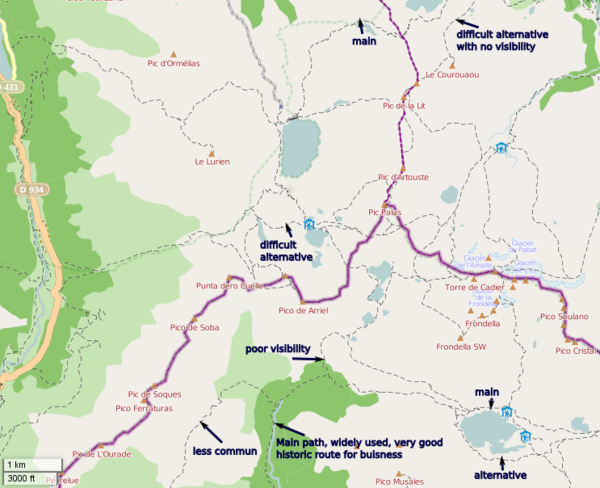Proposal:Pathtype
This proposition is under draft status, every one can modify it, and correct my bad English !
| Path classification | |
|---|---|
| Proposal status: | Draft (under way) |
| Proposed by: | Balaitous |
| Tagging: | pathtype=grade1-5 |
| Applies to: | |
| Definition: | Global classification for path |
| Statistics: |
|
| Draft started: | 2013-02-24 |
What ?
The purpose of this tag is to introduce a path classification.
Why ?
Path were added to OSM in december 2007 (Proposed features/Path). As the OSM database is growing, there are more and more commonly used. It became difficult to see which are widely used, with a good quality, and which are very few used. On the right, you can see an example of a such situation. You can see variants separated by only 50 meters.
Today
- roads are classified (highway=primary, highway=secondary, ...)
- tracks are classified (grade1, ..., grade5)
But there is nothing for a summarised path classification. The tags available for path are access=*, surface=*, sac_scale=*, trail_visibility=*, incline=*, width=*. There are little used, and none of them give a summarised information about the path.
How ?
Such as tracks, paths could be classified with a single pathtype=* tag, with values in grade1, ..., grade5.
The interest of a single tag is to become widely used. Worldwide, 44.34% of highway=track are associated with tracktype=*. In comparison, tag association for paths are :
- surface=* : 20.82%
- sac_scale=* : 7.06% (But only relevant for mountain hiking)
- trail_visibility=* : 4.61%
- width=* : 4.54%
To summarise path classification within a single tag, it must take into account the importance of the path, its quality.
Description
Usage
Pathtype is a measure of importance of a path. It usually applies to highway=path, but may also be used on other types of highway, when a hight pedestrian usage can be verified.
Different criteria are used to evaluate the importance of a path :
- Cultural : local knowledge of the path, history, attendance, ... Keep in mind that the cultural practice of walking travel varies depending on location. If it is tourism in some countries, in other it is a necessity in daily travels.
- Importance of the POI that the path relies. (POI = point of interest = point where peoples have an interest to go, not only touristic)
- State of the path : visibility, maintenance.
If each of those criteria can be measure with precision, the combination of all is something subjective. The scale of grades should be locally adapted to ensure in each region a good understanding of the relative importance of differents paths.
Others tags
This tag involves a degree of subjectivity in the classification. It is recommended make joint use of surface=*, trail_visibility=*, sac_scale=*, width=* tags to improve precision in path description.
Values
| Key | Value | Element | Comment |
|---|---|---|---|
| pathtype | grade1 | Main paths : Path culturally important, commonly used, with a route clearly established and regularly maintained. This path is long enough to travel between two major points of interest, or is part of such a path. Typically a long hiking route. | |
| pathtype | grade2 | Important path, frequently used, its route remains clearly established and satisfactory maintained This path connects (or is part of a route) between two nearby points of interest. | |
| pathtype | grade3 | Path of lesser importance, its route remains clearly established, but not always indicated by a special marking, more irregular maintenance can leaves little point obstacles. There may be variations for grade 1 and 2, or good path for local use. | |
| pathtype | grade4 | Minor Path, low traffic, it remains to connect two points of interest, but is distinguished from grade 3 or by a lack of maintenance that can require to depart from, or by a low visibility. There may be variations for grade 1 or 2, ancestral paths being abandoned or poorly local used path. | |
| pathtype | grade5 | Little used Path, the route is not always clearly identifiable, optionally interrupted in places. The maintenance is almost nonexistent, and the progress on this path is slowed by the presence of obstacles or vegetation. This path can be end in cul de sac without any POI. |
Rendering
The rendering should provide decreasing visibility from grade1 to grade5. Grade1 must appear before grade5. For example grade1 since zoom level 12, and grade5 not until zoom level 14 or 15.
For path without pathtype tag, the nearest tag is trail_visibility=*, so we can render those:
- as grade2 if trail_visibility=excellent/good/yes
- as grade3 if trail_visibility=intermediate or if not present
- as grade4 if trail_visibility=bad/horrible/no
Related propositions
There are other propositions to improve path description :
- Proposed features/Obstacle : Objective obstacles in a path (or highways) that difficult the passability.
- Proposed features/Local Hiking Scale : System for tagging a local hiking scale.
- Proposed features/Cairn : This proposal is not directly related to walking, but a cairn is also an important component in the markup of paths.
- Proposed features/path_defined_by : Alternative method of ranking paths by how they have been created.
Discussion
On the wiki :
On mailing list :
- Proposition for a classification of path
- Suppression GR dans OSM, oui, mais il faut autre chose first french discussion.
Voting
Not yet.

